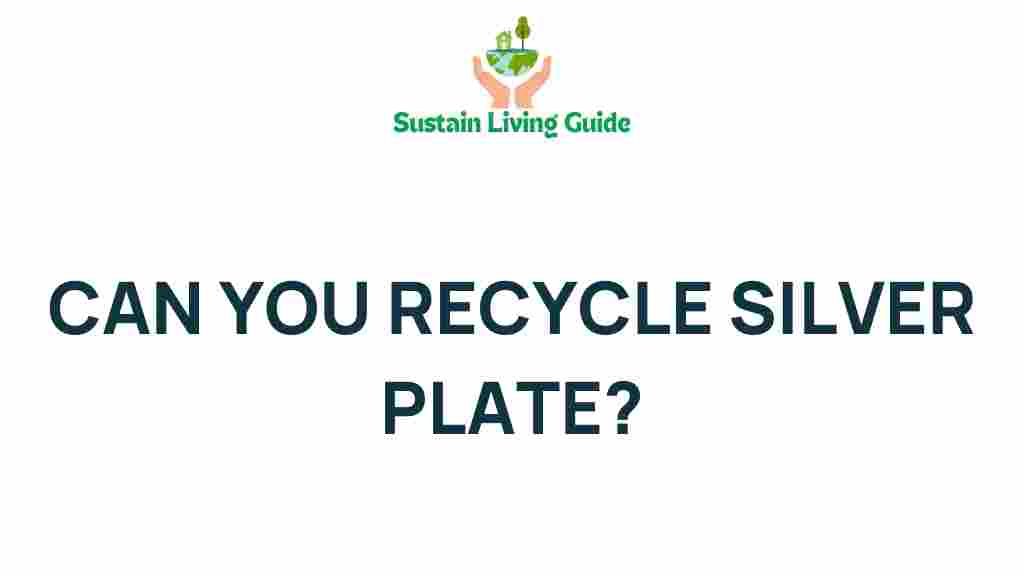Discovering the Truth: Can You Really Recycle Silver Plate?
If you’ve ever wondered about the fate of your old silver-plated items, you’re not alone. Many people are curious about whether they can recycle silver plate and what that process entails. In this article, we will delve into the world of silver plating, its recyclability, and how you can responsibly dispose of your silver-plated items. With sustainability being a primary concern for many today, understanding the recycling process is crucial.
What is Silver Plate?
Silver plate refers to a thin layer of silver that is applied to a base metal, such as copper or nickel. This process is achieved through electroplating, where a thin layer of silver is deposited onto the surface of the base metal. Silver-plated items are often more affordable than solid silver, making them popular for cutlery, serving dishes, and decorative objects.
Why Recycle Silver Plate?
Recycling silver plate can be beneficial for several reasons:
- Environmental Impact: Recycling helps reduce waste in landfills and conserves natural resources.
- Value Recovery: Silver has intrinsic value, and recycling can recover this precious metal.
- Sustainability: Supporting recycling initiatives promotes a more sustainable future.
How to Recycle Silver Plate
Now that we understand the importance of recycling, let’s explore the steps involved in recycling silver plate effectively.
Step 1: Identify Your Silver-Plated Items
First, determine which items you wish to recycle. Common silver-plated items include:
- Cutlery (forks, knives, spoons)
- Serving trays
- Teapots and coffee pots
- Picture frames
- Jewelry
Check for any markings on the items. Look for terms like “EP” (electroplated) or “Silver Plate.” These labels signify that the item is indeed silver-plated and not solid silver.
Step 2: Clean Your Silver-Plated Items
Before recycling, it’s essential to clean your silver-plated items. Here’s how:
- Wash with warm, soapy water and a soft cloth to remove dirt and grime.
- Dry thoroughly to avoid water spots.
- If tarnished, consider using a silver polish or a DIY solution (baking soda and water) to restore shine.
Cleaning will ensure that your items are in the best possible condition for recycling, increasing their value.
Step 3: Research Local Recycling Options
Not all recycling centers accept silver plate, so it’s crucial to do your research. Here are some options:
- Metal Recycling Centers: Many metal recyclers accept silver-plated items. Call ahead to confirm.
- Jewelry Stores: Some jewelers may buy silver-plated items for their metal content.
- Online Recycling Programs: Look for companies that specialize in precious metal recycling. Many offer mail-in options.
For more information on local recycling options, check out resources like Earth911, which can help you find recycling centers near you.
Step 4: Prepare for Recycling
Once you’ve selected a recycling option, prepare your items:
- Sort items based on type and quality.
- Remove any non-metal components (plastic handles, etc.).
- Pack items securely to prevent damage during transport.
Step 5: Take Your Items to the Recycling Center
Finally, transport your silver-plated items to the recycling center. Ensure you follow any guidelines provided by the recycling facility. After drop-off, you may receive compensation based on the weight and type of silver plate you’ve recycled.
Troubleshooting Tips for Recycling Silver Plate
While recycling silver plate can be straightforward, you may encounter some challenges. Here are troubleshooting tips to consider:
Tip 1: Finding the Right Recycling Center
If you struggle to find a recycling center that accepts silver plate, broaden your search. Consider:
- Contacting local scrap yards.
- Asking at thrift stores or antique shops if they have recommendations.
- Exploring social media or community forums for advice.
Tip 2: Confirming Silver Content
Sometimes, it can be difficult to ascertain whether an item is truly silver plate. If you’re unsure, consult a professional appraiser or jeweler. They can provide clarity on the metal content.
Tip 3: Dealing with Heavily Tarnished Items
If your silver-plated items are heavily tarnished, don’t despair! Here’s how to handle them:
- Use a commercial silver cleaner or a homemade solution.
- For intricate designs, consider using a soft toothbrush to reach crevices.
- Check if the tarnish affects the recycling process; if it’s too severe, some recyclers may refuse the item.
Conclusion
In conclusion, you can indeed recycle silver plate, which benefits both the environment and your wallet. By following the steps outlined in this article, you can responsibly dispose of your silver-plated items while ensuring that the precious metal is reclaimed. Remember to always check with local recycling centers for their specific guidelines and requirements.
Taking the initiative to recycle silver plate not only contributes to a sustainable future but also encourages others to consider their waste disposal methods. So, the next time you come across an old silver-plated item, remember that recycling is an option. Let’s work together towards a greener planet!
For more recycling tips and information, feel free to explore our other articles on eco-friendly practices. Together, we can make a difference!
This article is in the category Waste and created by SustainLivingGuide Team
